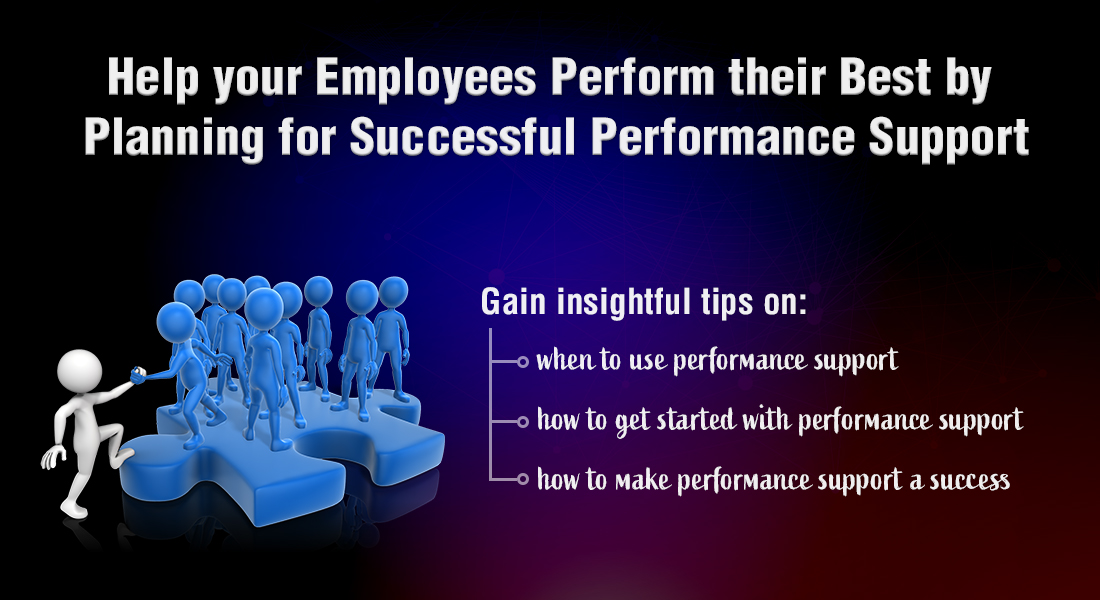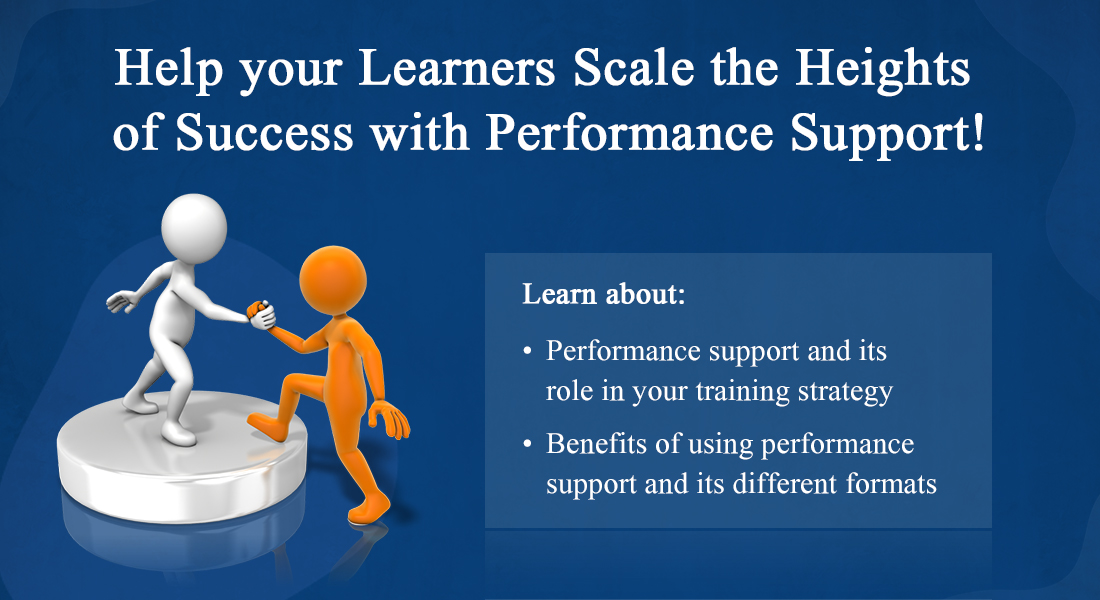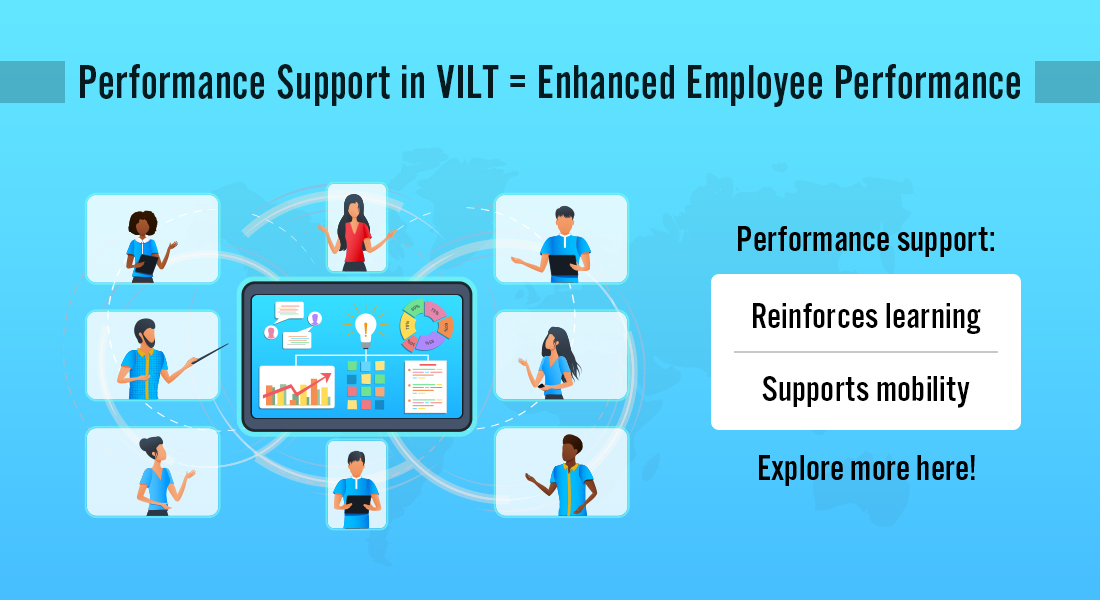Performance Support in Corporate Training (Part 2): The When and the How

Hello Training Managers! I have a question for you… “How far will you go to provide effective performance support for your employees ?”
Planning for Performance Support in Corporate Training
1. Performance Support: When?
- High-risk job tasks
- Complex job-tasks
- Constantly evolving job-tasks
2. Performance Support: How?
- Short and relevant information
- Flexible learning formats
- Mobile responsive tools
As leaders in corporate L&D, you know how important performance support is for boosting employee efficiency. So, as promised, today we’ll be continuing our discussion on performance support in corporate training. In the first part of this article, ‘Performance Support in Corporate Training: The What and the Why (Part1)’, we had just started on our discussion on what performance support is, the role it plays in your training strategy, its benefits, and formats. Today, we’ll explore the planning and implementation of performance support.
- when to use performance support
- how to get started with performance support
- how to make performance support a success
So…without further ado, let’s get started!
Register for a free webinar to learn the secrets to become an eLearning champion.
The Right Time for Performance Support
When is the right time for providing your workers with performance support? Well… the short answer is, ‘Always’. But, we all know that is not always possible (what with budget constraints and all). So, perhaps a better question would be, ‘When is performance support necessary?’
Here are some instances when providing performance support is the best course of action for both your learners as well as your organization:
- When the task involves high risk and there should be no margin for error.
- When the task is performed very infrequently (when it is likely that employees will not remember how to do it).
- When the task involves performing multiple steps in the correct sequence (when one misstep can lead to failure).
- When the task involves constantly changing or evolving course of action (e.g. Standard Operating Procedures for compliance).
- When the task is too complex to be done from memory (when learners need to continuously refer to a guide to do it).
Getting Started with Performance Support
Now that you know when you should provide performance support, it is time to plan your strategy for the best way to do it. Because, let’s be honest, your stakeholders are going to need some convincing when you tell them you’re planning for some sort of training support after formal training. Also, while performance support is part of your training strategy, it’s not the same as formal training and so, you have to come up with a different sort of plan.
And what plan is that? Well… in the book ‘Innovative Performance Support’, authors Gottfredson and Mosher talk about conducting a Rapid Task Analysis (RTA) to quickly identify and prioritize higher-level tasks rather than focusing on the details. An RTA will help identify where performance support is needed most and what strategy you should employ.
There are 3 steps to conducting an RTA:
- Step 1: Deconstructing job tasks to get a quick overview so that you can identify where to provide performance support. You don’t need to identify all the steps of each task at this stage; you will be doing that later in the process.
- Step 2: Going deep into the job task and understanding the high-level concept involved. This will give you an understanding of what the task is, where the task fits into the big picture, and how important it is to the organization. This will help prioritize the task for which performance support is critical.
- Step 3: Coming up with a strategy for performance support and planning on how to deliver to learners.
Let’s discuss how to create successful performance support next!
Make Performance Support a Success!
1. Deliver Information in Short & Compact Bursts
Performance support is not formal training. There is no need for employees to dedicate a special time to access performance support, it is to be used in the flow of work. So, the longer the performance support is, the more time your employees will spend on it that they could have spent working. With performance support, the content has to be crisp and concise. That is why microlearning is considered the best option for performance support. Each microlearning module focuses on one learning objective and delivers bite-sized information which employees can access – just what they need, when they need it.
2. Ensure the Performance Support Content is Relevant and Up-to-date
Formal training, whether classroom training or eLearning, is designed to explore a given topic in detail, teach learners new information and skills, and instruct them on how to apply it in their jobs. On the other hand, performance support aims to reinforce the learning gained through formal training and help learners apply that learning to resolve job tasks. There is no room for ‘nice-to-know’ information here, it should be very relevant to the job task at hand and focus on getting the job done.
Also, since performance support, unlike format training, is used to deliver just-in-time learning that employees use constantly in the flow of work, the training content has to be relevant and up-to-date.
3. Provide Flexibility to Learners in the Choice of Learning Formats
The best thing about performance support is that it can be delivered in multiple formats, a few examples being micro videos, podcasts, webcasts, short quizzes, animations, games, etc. This gives you a unique opportunity to make the whole thing more learners-centric and offer learners a choice of formats to choose from. After all, if learners could choose how they learn, that is bound to make a difference. And ultimately, they will end up becoming more efficient and skilled because of it.
4. Ensure your Performance Support Tools are Mobile Responsive
Performance support is meant to be accessible anytime, anywhere, at the demand of employees. Can it happen if employees are offered access to it only through their desktops? What about all those employees who work off-site on the field or who work remotely? Making performance support tools mobile responsive is a must to make it a success.
Wrapping it Up!
So, how did you find this all-in guide for performance support? Do you agree with me on the importance of performance support in corporate training? I have to let you into a secret – the key to creating the perfect performance support strategy is to leverage the power of microlearning. Using microlearning for performance support is the best way to make it a success.
Don’t believe me? Well, you can explore the powers and benefits of microlearning for yourself. Download our free eBook to help you along the way.





